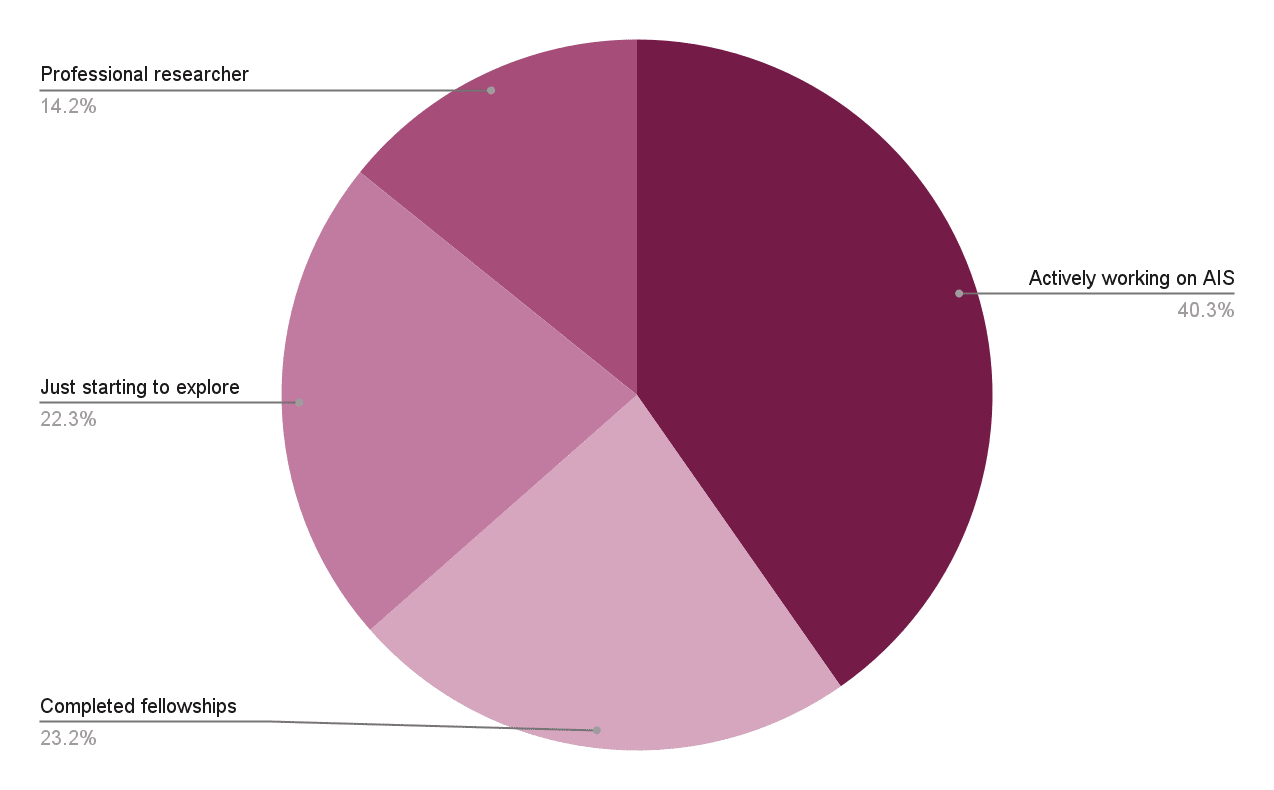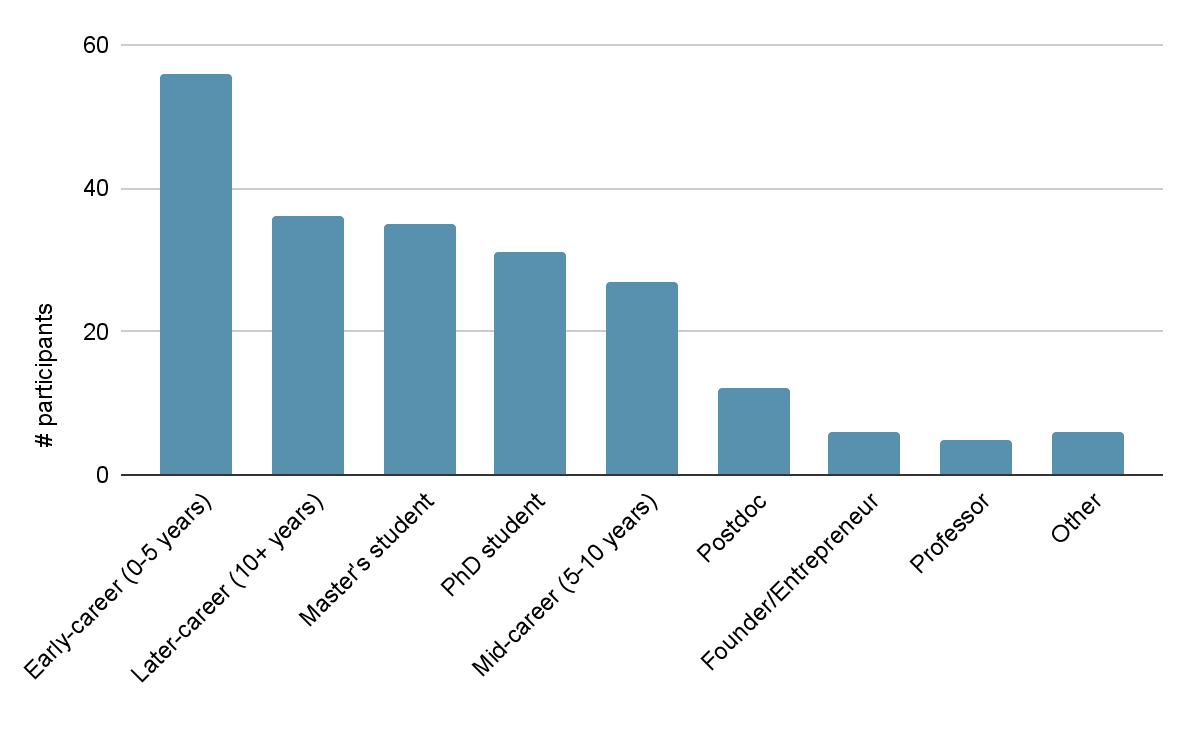Published on November 11, 2025 5:00 PM GMT
TL;DR: The Zurich AI Safety Day - a one-day conference in Zurich of more than 200 participants - was a new event format to bring together the AI safety field across Europe and tap into the local talent pool. The feedback received was very positive, and the event could serve as a foundation to learn from for future cause-area specific conferences. This post summarizes the rough numbers, goals, feedback received, and learnings from the event.
“I found out that AI safety is sexy now.” - This was among the feedback we received for the Zurich AI Safety Day. But what was the Zurich AI Safety Day all about?
A Conference Dedicated to AI Safety
On Saturday, September 27, we organized the <a href=“http…
Published on November 11, 2025 5:00 PM GMT
TL;DR: The Zurich AI Safety Day - a one-day conference in Zurich of more than 200 participants - was a new event format to bring together the AI safety field across Europe and tap into the local talent pool. The feedback received was very positive, and the event could serve as a foundation to learn from for future cause-area specific conferences. This post summarizes the rough numbers, goals, feedback received, and learnings from the event.
“I found out that AI safety is sexy now.” - This was among the feedback we received for the Zurich AI Safety Day. But what was the Zurich AI Safety Day all about?
A Conference Dedicated to AI Safety
On Saturday, September 27, we organized the Zurich AI Safety Day. For 10 hours, more than 200 people interested in AI Safety from across Europe met to exchange ideas, find new collaborations, and learn about pathways to a safer development of AGI. The conference hosted 14 talks and workshops and an Org Fair with more than 20 organizations in the field, including UK AISI, Apollo Research, FAR.AI, and Palisade Research. It was organized in collaboration between BlueDot Impact and Zurich AI Safety and supported financially by Open Philanthropy.
There were three main goals for the event:
- Get more senior talent and motivated newcomers involved with the field
- Conferences can get a lot more visibility on public platforms than small events or activities of associations. At the same time, Zurich has strong talent pipelines for technical AI safety work in the form of universities like ETH Zurich, and with many big tech companies present, including Google DeepMind. Onboarding these talents into the field and making them aware of the issues was one of the priorities for the event.
- To catch talent that is working in the context of AI, a labelling of the conference as an AI safety conference seemed better than labelling it as an Effective Altruism conference.
- Strengthen the Swiss and European AI safety ecosystem by connecting various stakeholders around the topic
- Connecting different actors within a high-impact field with each other has proven successful in inspiring new ideas and collaborations across EAG(x) conferences.
- In contrast to having this exchange on an EAG(x) conference, a dedicated AI safety conference can help create a shared identity for the field and strengthen the connections to non-EA organizations working on related issues in the local ecosystem.
- Set up Zurich for further AI safety field building
- This basically loops back to the first goal, but with the perspective of continuously getting more talent in Zurich involved with AI safety. The conference helped build a lot of momentum for this goal.
In this summary of the goals, I have outlined some of the advantages that a dedicated AI safety conference can have compared to EAG(x) conferences. I have discussed this in more detail in another post on cause-area specific conferences.
Feedback and Learnings
Before getting to the specific learnings that might be interesting for those who are trying to set up something similar, I want to share some numbers and some of the feedback that we received after the Zurich AI Safety Day.
How participants experienced the event
Overall, the feedback was very positive. Some quotes that stood out:
- “I got inspired from various chats. It shaped a direction for me to take the next steps instead of staying where I am and feeling lost.”
- “It was very nice for me to learn from PhDs and talk to some possible supervisors for my PhD applications.”
By the numbers:
- Feedback rate: 34% (85 responses)
- Average rating: 4.63/5
- 74% of attendees rated attending the conference as significantly (≥3x-10x) or exceptionally (≥10x) better than alternative uses of their time.
- Approximately 5 new meaningful connections per attendee.
- 80% of attendees decided on concrete next steps as a result of attending the conference.
Some qualitative highlights of the event include:
- Out of more than 230 events, the AI safety day won the “Best Event in Swiss AI Weeks” award from a local performance art group in Zurich. This is an example of positive chain effects from organizing bigger events. The Zurich AI Safety group gained increased visibility and a new local connection to the artists as a result.
- Some of the representatives of the present AI safety organizations rated the value of attending this conference between attending an EAGx and an EAG conference, some even above attending an EAG conference.
- Most valuable aspects for participants were 1-1 networking (67% of respondents selected this among the most meaningful parts of the conference), informal connections (58%), and the Org Fair (50%).
- The Org Fair was also highlighted in individual feedback. The Org Fair took place in parallel to lunch in the big exhibition hall and hosted booths for all of the participating organizations. It catalyzed many new connections, according to participant feedback.
- Career-transition guidance was very valuable for early-career and senior newcomers alike.
What we learned for future conferences
In organizing this conference, we started from a very motivated group of volunteers who were experienced with field building in AI safety, but had only limited experience in organizing conferences. Consequently, there was a lot to be learned for the team throughout the process of organizing the conference, and I want to share some specific learnings for this kind of conference here.
What worked well?
I have already shared some of the things that worked well, and that I would encourage people organizing similar events to include, like an Org Fair. An additional thing that worked well for us, when selecting out of more than 350 applications, was aiming for a mix of 60% of people with experience in the AI safety field and 40% of people new to the field.

The above graph shows the actual distribution of what people reported as their experience level. The ones reported as professional researchers are effectively people new to AI safety. With 36.5% of newcomers, we approximately reached the target of having 40% of participants new to the field. The representatives of AI safety orgs reported a good balance in the experience of the people they talked to. In the same context, the conference was also joined by people of very diverse career stages, with only 25.5% of participants being part of the biggest career stage (early-career professionals) (see graph below for career stage categories).

Another thing to highlight was the speaker brunch that we hosted on Sunday morning, the day after the conference. With most representatives of the organizations still in town, we invited them to the brunch, which enabled exchange between the groups outside of the more hectic conference atmosphere.
A few more things that went well, and seem valuable to repeat in similar events:
- We moderated the opening and closing sessions ourselves to set the tone of the day. People were generally excited about these sessions and were very involved in the short exercises that we included. Those were goal-setting and reflection exercises, with consequent discussion with the neighbours.
- When getting started, it proved very useful to first approach some organizations that we already had some ties to and ask them if they wanted to join. Based on their accepted participation, it was getting easier and easier to get more organizations involved and gain initial momentum and visibility through that.
What could be improved?
In the aftermath of the event, we sat down and wrote down a list of things that could be improved in another iteration of such an event or that didn’t work. A common pattern among many of these things was that we were rather late with some steps of the organization that require longer timelines. Given the perceived urgency in the context of rapid AI advancements, we were probably a little bit impatient. As a result, we only had one month between receiving the confirmation of funding and the event date. We had made preparations for tasks with longer time horizons before that, but, for example, could only commit to arranging all the details with the venue after receiving the grant. The venue was the local university, ETH Zurich, and only because we had a recognized student organization there were we able to set things up in advance of receiving funding, mostly for free. Since the same applied to other university groups, another event ended up happening in the same building, which led to some routing confusion on the event day and limited the capacity of the venue staff.
This brings me to a list of some of the other things that could be improved:
- We were also short on time setting up Swapcard as an event app, which led to some of the networking features not being presented, resulting in more difficulties finding the right people to talk to. Things like that should be triple-checked.
- We could better prepare for short-term changes in speaker availability
- We printed the schedule a week in advance and then distributed these prints despite changes that happened in the meantime. This led to more confusion than benefits, and relying primarily on Swapcard seems like the better alternative.
- We had varying slot lengths for submissions, which made it harder to move sessions to fill gaps. This was due to having different parallel tracks in the afternoon (technical, governance, careers). The tracks seemed very useful and provided a good structure, but could likely also work in an EAG(x) style patterning of slots of multiples of 30 minutes throughout the day.
- We reached out to the press and politicians to facilitate some discussion around AI risks, but no one ended up participating on that end. This wasn’t a core goal of the event anyway, but it is also not clear whether there are alternative approaches to outreach that could have worked better.
- To increase flexibility, it seems useful to book backup rooms (particularly if you can book them for free). If not needed for sessions, they can be used for storage, rest, multi-faith, children, etc.
- For first-time events, a significant financial buffer seems useful, possibly beyond 10%, up to 20%. We actually ended up having this buffer, but rather accidentally, since we didn’t pay as much as expected for the venue.
Final thoughts
All things considered, the event seems like a success, and these learnings can be valuable for future iterations of AI safety days, either in Zurich or elsewhere. The whole thing started as an idea in a BlueDot Impact discussion group and ended up as a promising event that clearly exceeded the expectations in scale of what we ourselves thought possible to happen in Zurich. In my opinion, this shows that grassroots initiatives can work, and I encourage everyone to sometimes just try executing on new project ideas. I think the AI safety field is still much too small, and I am excited to see new initiatives come to life!
Discuss